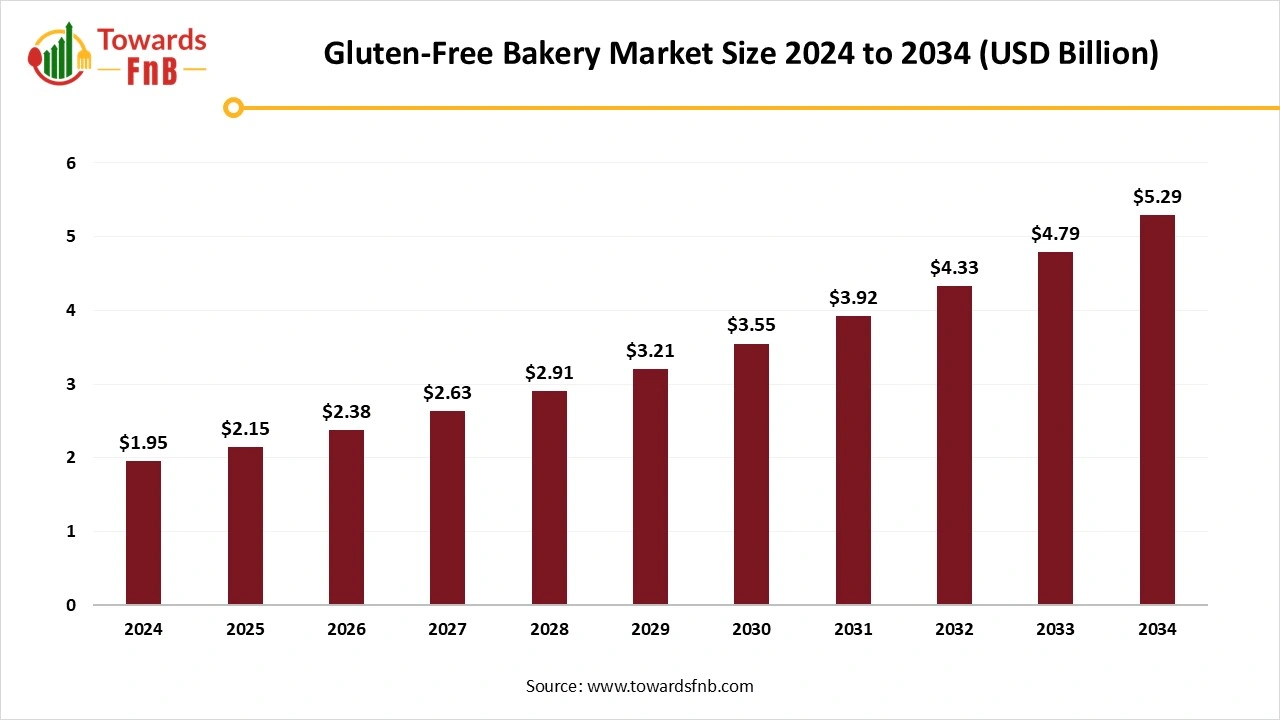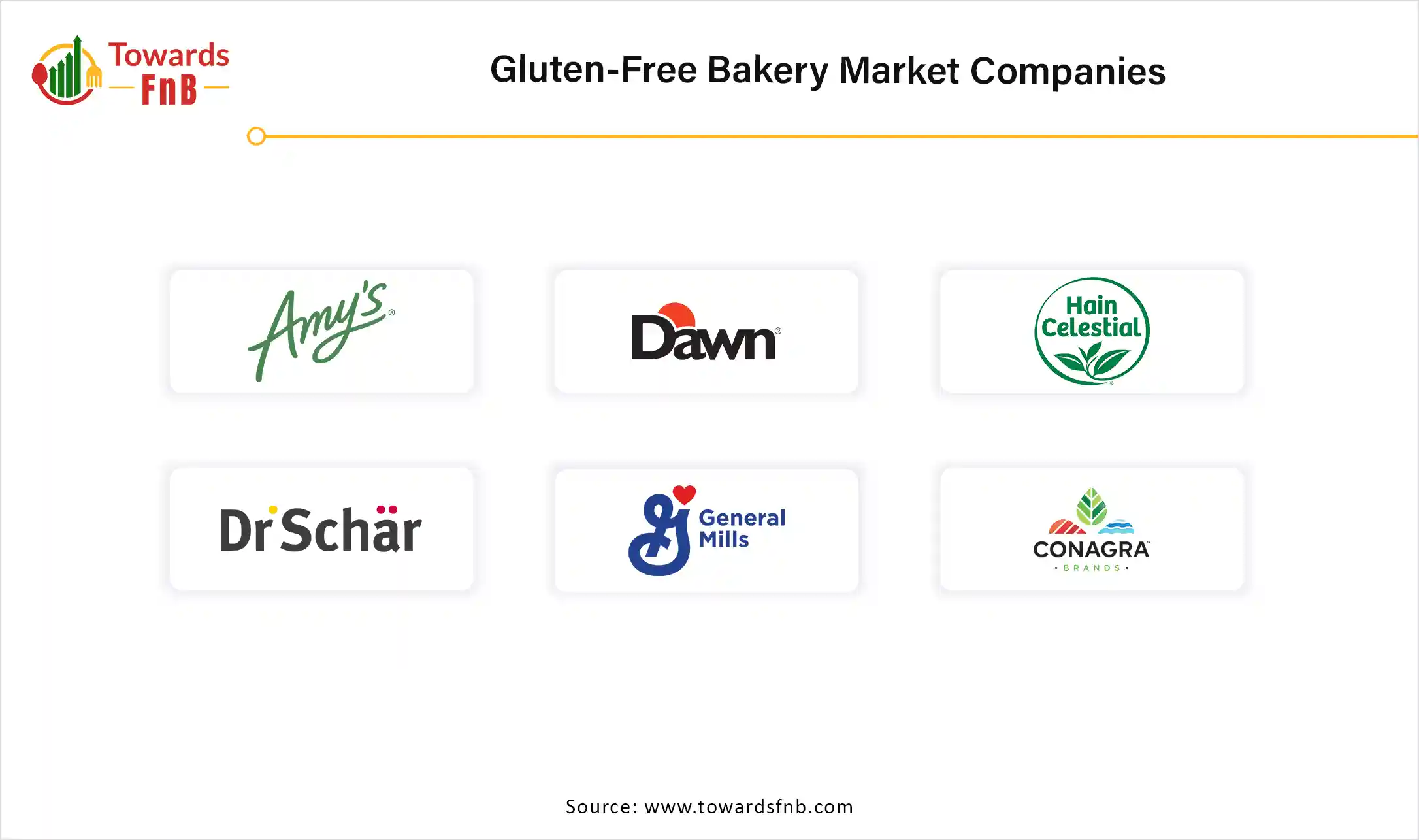December 2025
The global gluten-free bakery market size was reached at USD 1.95 billion in 2024 and is predicted to increase from USD 2.15 billion in 2025 to approximately USD 5.29 billion by 2034, expanding at a CAGR of 10.5% during the forecast period from 2025 to 2034. The global gluten-free bakery market is attributed to the increasing demand for nutritional and healthy food products.

| Study Coverage | Details |
| Growth Rate from 2025 to 2034 | CAGR of 10.5% |
| Market Size in 2025 | USD 2.15 Billion |
| Market Size in 2026 | USD 2.38 Billion |
| Market Size by 2034 | USD 5.29 Billion |
| Largest Market | North America |
| Base Year | 2024 |
| Forecast Period | 2025 to 2034 |
| Regions Covered | North America, Europe, Asia-Pacific, Latin America, and Middle East & Africa |
The gluten-free bakery market specializes in the production of gluten-free products, especially cakes, pastries, or bread. Gluten is a protein found in various cereals including rye, barley, and wheat. Gluten-free bakeries use alternative flours including buckwheat, quinoa, corn, and rice, to serve the needs of consumers with intolerances and allergies. To enjoy bakery product safely and without compromising consumer health, they enable those with gluten sensitivity and intolerance. Gluten-free food items improve energy levels, digestive systems, and cholesterol levels. In addition, the market for gluten-free bakery is witnessing rapid growth due to factors such as rising urbanization, increasing disposable income, increasing prevalence of celiac disease across the globe, increasing disease cases and food allergy, and increasing availability of a wide quality and variety of gluten-free food items.
One of the major factors driving market growth is the growing adoption of alternative flours. A variety of alternative flours are used rapidly in the gluten-free baking market, to enhance the texture and flavor of gluten-free products. Ancient grain flours such as legume flours such as chickpeas, amaranth, teff, and quinoa are becoming more popular among consumers. By having higher fiber and protein contents and distinctive textures and aromas, these alternative flours provide consumers with better nutritional profiles. The increasing consumer preference towards nutrient-dense foods and increasing dietary sensitivity awareness increased the need to avoid the drawbacks of gluten-free baking, such as poor flavor and texture are expected to drive the growth of the gluten-free bakery market.
The growing product variety and improved accessibility may create growth opportunities in the market. By offering a wider range of gluten-free bakery items, manufacturers are serving this increasing demand. This involves alternatives made with additive flours such as coconut, chickpea, and almond which ensure there are options that suit dietary needs and diverse taste preferences.
In addition, to mainstream online retail and supermarkets platforms, the availability of gluten-free items increased beyond health food stores. Furthermore, online retailers and supermarkets are continuously following gluten-free bakery products to make them convenient for customers across the globe. These growth opportunities are expected to revolutionize the growth of the gluten-free bakery market in the coming years.
To make gluten-free baked food products, it needs the use of specialty items, which are very costly as compared to wheat flour. Gluten-free items such as gluten-free alternative flours and flour blends are very costly as compared to traditional wheat flour, which may create major challenges in the market. This may reflect in the final cost for consumers and convert into higher production cost for manufacturers. This may create a challenge for budget-aware consumers, which is further expected to restrain the growth of the gluten-free bakery market.
How does North America Revolutionize the Gluten-Free Bakery Market in 2025?
North America dominated the market share in 2024. The market growth in the region is attributed to the increasing demand from the younger population and millennials for convenience and healthy food, increasing demand for healthy diets foods, increasing prevalence of celiac diseases, and the growing significant population. The U.S. and Canada are dominating countries driving the market growth.
U.S. Dominance on the Market Share in 2024
The U.S. dominated the gluten-free bakery market in 2024. due to factors such as increasing demand for gluten-free bread, increasing popularity of clean-label products, and rising demand for non-GMO, allergen-free, and gluten-free foods. There are various gluten-free bakeries in the U.S. that are focusing on aiming the result to conventional foods, from breakfast sandwiches to pastries, sweets, biscuits, and doughnuts, and offer a variety of frozen take-and-bake food products. In the U.S., grocery shoppers represent 93.9% of baked goods distribution.
Retail sales of gluten-free baked products by category in the U.S. in 2023.
How Asia Pacific is Revolutionize Market Growth?
Asia Pacific expects significant growth in the market during the forecast period. The market growth in the region is driven by factors such as increasing demand for the processed food industry, rising demand for demand for gluten-free foods, increasing consumer awareness related to celiac disease, and increasing awareness related to health benefits. China, India, Japan, and South Korea are the fastest growing countries driving the market growth in this region.
Gluten-Free Bakery Market Trends in India
India is expected to grow fastest during the forecast period which is driven by well-developed bakery and food processing industry, increasing disposable incomes, changing dietary preferences, and increasing presence of major urban centers.
The Bread Segment Dominated the Gluten-Free Bakery Market in 2024.
The segment growth in the market is attributed to the increasing consumption of gluten-free bread, increasing working and busy population, increasing demand for convenient and quick food, and rising demand for low-carb wheat-free bread, rye-free, and gluten-free bread. In addition, various benefits of gluten-free bread are expected to accelerate the market demand, such as maintaining freshness, a rich source of fiber, helping in weight loss, relief from some digestive symptoms, and managing celiac disease, which is further expected to drive the market growth.
The Biscuits and Cookies Segment Expects Fastest Growth in the Market During the Forecast Period.
The segment growth in the gluten-free bakery market is attributed to factors such as the growing food processing industry, increasing demand for healthy cookies, especially across children, increasing consumer preference towards health and wellness, rising busy lifestyles, and increasing consumer trends towards healthy diets and foods. Gluten-free cookies have motivated creativity in bakeries across the globe. Manufacturers or bakers have developed a wide range of exciting and unique flavors in gluten-free cookies and biscuits, with the need to explore alternative ingredients and flours. For instance, across the 13 European countries, 7296 gluten-free consumers responded to an online survey on the 33 types of gluten-free products purchased. In 2024, the market for gluten-free food products is worth USD 3.62 billion in Europe.
The Supermarkets and Hypermarkets Segment Dominated the Gluten-Free Bakery Market in 2024.
The segment growth in the market is driven by product availability and convenience, increasing consumer preference to shop at traditional supermarkets, increasing availability of healthy food products, and growing a strong offline retail chain. Retailers have enjoyed the intense consumer loyalty and higher margins that come with gluten-free bakeries. The demand for gluten-free bakeries is growing rapidly across the various supermarkets or hypermarkets across the globe, where consumers can find millions of gluten-free bakery products integrated throughout the stores. For instance, 80% of the company’s bakery products are gluten-free, due to this, manufacturers are incorporating more natural ingredients and have enhanced the taste of their products, which further drives the demand for supermarkets or hypermarkets in the global market.
Here are the five biggest retailers and their revenue figures in 2024
The online retail segment is expected to grow fastest during the forecast period. The segment growth in the gluten-free bakery market is attributed to the growing e-commerce platforms, rising number of smartphone users, increasing use of shopping websites, and trend of online shopping. The top three reasons shoppers buy online groceries in the U.S. are 38% of shoppers' ease of comparing prices and products, 41% of shoppers avoiding impulse purchases, and 77% of shoppers saving time. In the U.S., over 138 million consumers shop for groceries online in 2024. Industry generated 257 billion in revenue in the U.S. in 2024.
Wildgrain
T. Marzetti Co.

By Product
By Distribution Channel
By Region
December 2025
December 2025
December 2025
December 2025